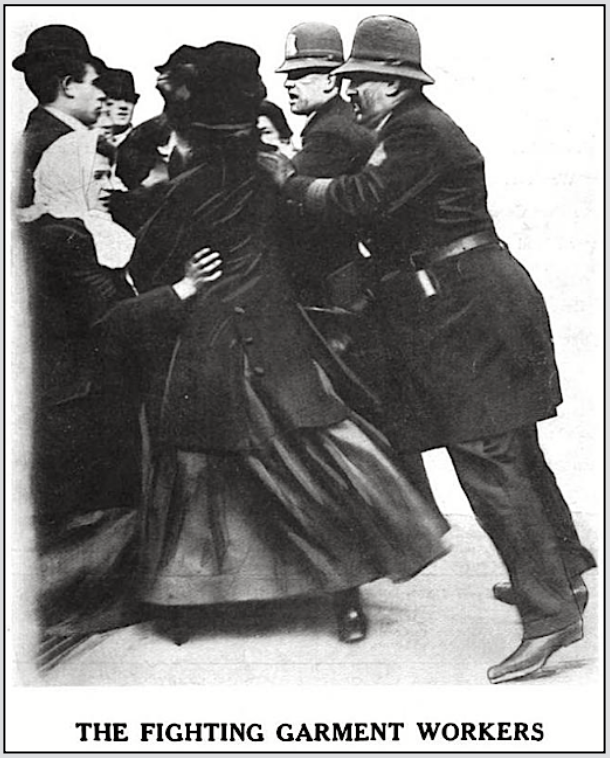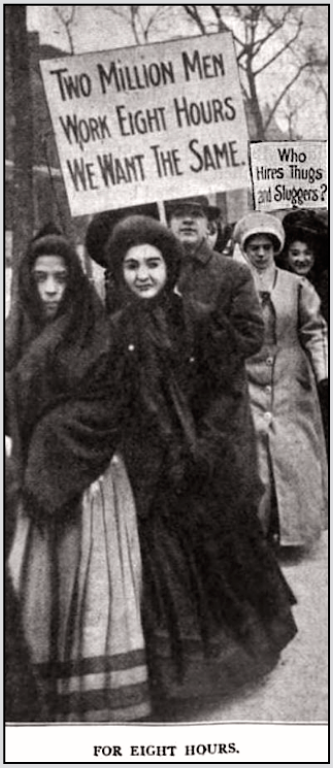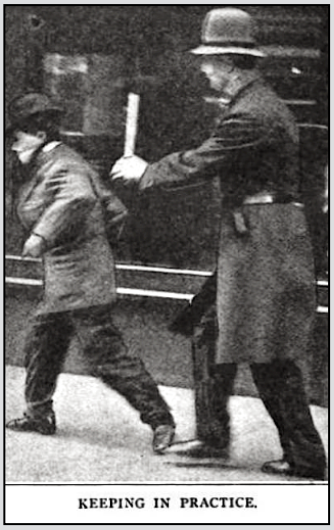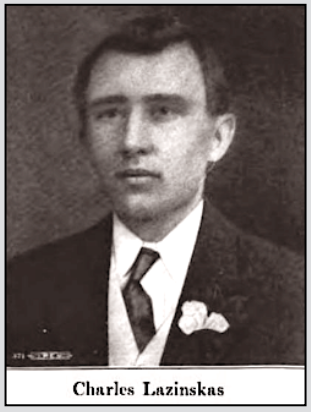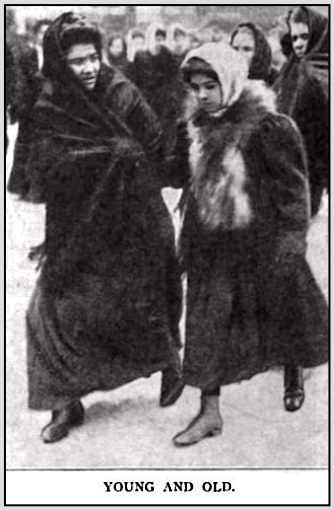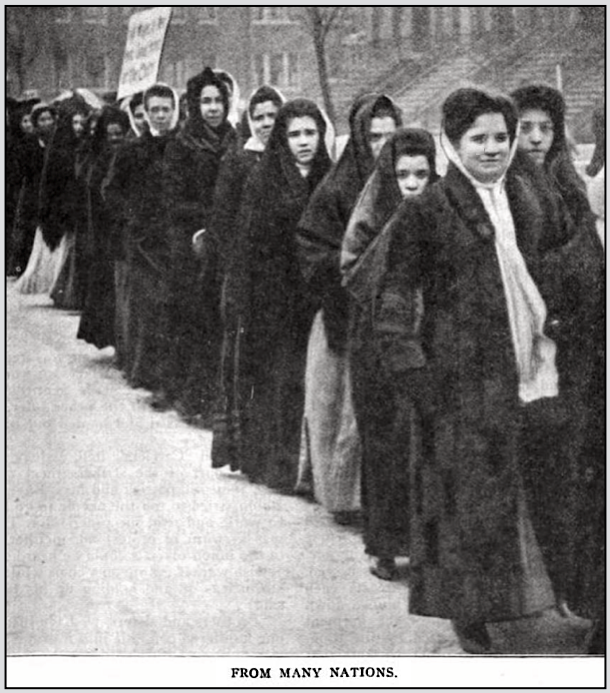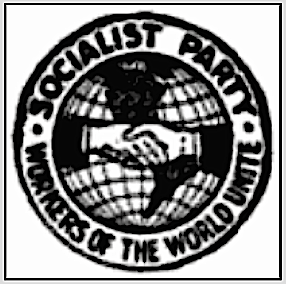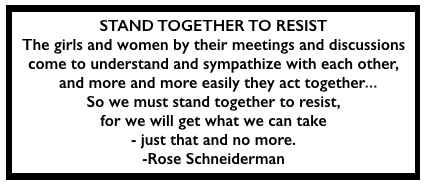 ———-
———-
Hellraisers Journal – Wednesday January 4, 1911
Chicago, Illinois – Garment Workers Strike Continues, Part II
From the International Socialist Review of January 1911:
BY ROBERT DVORAK
[Part II of II.]
The most admirable and contagious strike meetings were held in thirty-seven various halls in the city and money was pouring in from all parts of the country, with letters of encouragement and promise of further aid when another blow, again from union headquarters, once more nearly demoralized the strikers.
Alderman Charles E. Merriam, pressed by some outside influential persons, brought the strike question up at the council meeting Monday, Nov. 28, and asked that a committee be appointed by the city body for the purpose of trying to end the strike. Mayor Fred Busse, City Clerk Francis D. Connery, and Aldermen Chas. E. Merriam, William F. Ryan and Winfield P. Dunn were elected on the committee.
The Chicago Federation of Labor was represented by John Fitzpatrick, at the subsequent meetings. the garment strikers by Edward Anderson, the garment workers’ union by Samuel Landers. national organizer, and the Women’s Trade Union League by Mrs. Raymond Robins. Hart, Schaffner and Marx stock holders were represented by Levy Mayer and Harry Hart.
Four locked door meetings were held in the mayor’s office and not a soul outside of the main strike committee knew what was going on. Then the silence was broken and another peace offer was flaunted before the eyes of the workers.
Great wordy speeches accompanied the reading of the agreement by the union officials, but no amount of flowery talk and beautiful visions of organization at a later day could cover the fact that the new peace offer was only a repetition with but one exception of the brand submitted by Rickert, more than a month previous, and another storm of dissent greeted Fitzpatrick and his assistants when they read it at the meetings.
Not even the fact that the agreement had been recommended for acceptance by the Chicago Federation of Labor delegates could alter the strikers’ feeling, and Fitzpatrick, like Rickert, discovered that he was dealing with unorganized but well posted workers, who knew what they wanted and refused to be told what to do and when to do it.
The Fitzpatrick agreement again guaranteed the strikers a position within fifteen days without regard to whether they were strikers or not, and specified that an arbitration committee of five members, two of the union, two of the manufacturers and one to be chosen by the four, was to be appointed to settle all grievances. It further stated that no discrimination was to be practiced against either the union or non-union employes.
Seeing that no amount of cajoling, entreating or intimidation could get the strikers back to work, and fearing to submit the agreement point blank in person, Fitzpatrick and the strike board decided to take a secret ballot vote after the bitterness had died down somewhat.
Mrs. Robins and the Women’s Trade Union League adopted a new policy, however, and began the work by giving out horror-inspiring interviews to capitalist press reporters on the terrible suffering and extreme starvation among the strikers.
Columns of interviews bearing directly on suffering of the strikers were given out by Mrs. Robins, and the capitalist papers featured these with extra coloring and display. A picture taken early in the strike showing a group of Jewish and Italian strikers was printed and declared to be that of families evicted by landlords for non-payment of rent, said to be living in one room.
The strikers condemned the stories, and votes taken in the various halls failed to show one person who had suffered from starvation or even the slightest lack of food.
Mayor Busse and his aldermanic committee tried their best to secure a similar agreement to that signed by Hart, Schaffner and Marx from the Wholesale and National Clothiers’ Association, but these worthy gentlemen laughed and told him that Hart, Schaffner and Marx brought the strike on and could fight it out itself. They refused to arbitrate through their representative, Martin I. Isaacs, and the city hall attempt to aid the great strike was a fizzle of the worst kind.
Following the sentiment expressed by the strikers for rejecting the last agreement of the Hart, Schaffner and Marx concerns, the Socialist party stepped in and determined to aid financially so determined a band of workers.
At its meeting, Sunday, December 11, the national executive committee of the Socialist party passed a motion instructing the secretary to insert an emphatic appeal in the coming issue of the National Bulletin, calling upon all Socialists to aid to their utmost the striking garment workers.
The Cook county central and delegate committee, at a meeting on the same date, instructed the secretary to issue subscription lists and to do his utmost to secure funds for the strikers. The delegates further instructed the editor of the Daily Socialist to insert a permanent appeal for funds in the columns of the paper.
While the negotiations for peace were going on, the strikers were suffering from the razors, knives, clubs and revolvers of the hired sluggers, special detectives and armed strike breakers who were furnished with weapons by the strike-bound concerns. No person daring so much as brush up against a strike breaker was sure of his life, for the beasts in human skin had an ever-handy revolver or other weapon ready to kill or maim.
The first weeks of the strike, the sluggers and “detectives” used only clubs with which they broke the heads of more than a score of strikers. Later they gained courage and displayed revolvers and steel knuckles. Not being interfered with by the police, they began to fire the revolvers and use the knuckles openly. Finally they began to take aim and a number of strikers, women and men, fell to the ground shot with bullets furnished by their employers.
Finding the hiring of special detectives and sluggers a little too expensive the owners of sweatshops armed their scabs with firearms and a girl striker lost a finger as a result of this new and money-saving move.
She and a few of her companions had gathered near the home of a girl scab and tried by persuasion to bring her to their ranks. An automobile drove up while they were arguing with her. She jumped into it. A brother of the girl scab lifted a rifle to his shoulder, a shot echoed and Miss…………had one finger less.
Every day strikers reported to headquarters with tales of how they had been shot at and attacked by armed strike breakers. Protests galore were made to Leroy T. Steward, chief of police, but he only shook his head sagely and said: “Wait until the strike is over.”
Then all at once, while the peace conference in Mayor Busse’s office was going on, Charles Lazinskas, a striking garment worker, was attacked while speaking to several scab girls in front of the Royal Tailors’ establishment, and shot through the heart by Martin Yacullo, a tailor, who had been made a special detective by the strike-bound company.
The murder acted like a spark in a pan of gunpowder. Not one striker had committed any violence up to this point. Some had broken windows, true enough, but no person had been seriously, or other wise, hurt by the strikers. The murder of their comrade, however, fanned the strikers into a fury and several detectives were beaten so badly the following day that they had to be taken to a hospital.
Even the police were stirred into activity and an order was issued to the policemen to arrest any person caught carrying concealed weapons of any kind. At an inquest held over the dead body of Lazinskas the coroner’s jury held the murderer, Yacullo, to the grand jury.
There never was a funeral in Chicago such as was held in the case of the murdered garment striker. Thousands of men, women and girls followed the hearse that carried the body of their comrade.
They marched with their heads bowed. On their coat lapels and breasts each striker had a piece of crepe pinned down with the union button of the garment workers. Banners carried by the thousands proclaimed to other workers that another person had fallen victim to the greed of the employers.
Every person who took part in the funeral march swore solemnly that he or she would never go back to work until the bosses gave them what they wanted or at least a big part of it. They condemned the pending agreement in the most bitter terms, but the Chicago Federation of Labor would not be warned, and various attempts were made to force the agreement upon the strikers at various meetings. Speakers were sent out to talk the people into the peace offer, but these were hissed and hooted out of the halls.
At Hod Carriers’ hall, where the largest part of the strikers meet every day, John Fitzpatrick and Mrs. Raymond Robins tried to tell the people to go back to work, and read the peace offer. There was a storm of protest and neither one of the union officials could be heard. One Jewish worker got up on a chair while the storm was on and holding up his hands said:
Brothers and sisters, we have just put our murdered comrade into a grave. He was fighting with us against the murderers who own the big tailor shops. He was killed by a man who was given a gun and bullets by the bosses. Now they want us to go back to work and offer us nothing.
Just think, my brothers and sisters, of how we have been clubbed, shot at, robbed and murdered. It was all because we wanted better conditions. Now they bring us an agreement that is nothing and tell us to go back. I say no, brothers, I say no—and I know that poor Lazinskas in his grave would say no too.
There was a storm of applause that could not be quieted when the speaker finished and the crowd began to surge threateningly against the platform where only a little over a month before Robert Noren had almost received a beating at the hands of the strikers when the Rickert agreement was proposed.
The funeral of Lazinskas was held on Monday, December 5, and was viewed by thousands of people. The Wednesday following 50,000 strikers left their homes early in the morning, and braving the cutting wind, marched for two hours through the streets of Chicago in a protest against police brutality, murderous sluggers and the conditions in the tailor shops.
Following the parade, the police brutality stopped to a large extent and several strike breakers caught with concealed weapons were arrested for the first time since the beginning of the strike. Public sentiment at last won a slight victory.
As a sample of the police tactics used against the strikers and their extreme brutality it is only necessary to cite the case of Frank Kriz, living at Trumbull avenue and Twenty-fifth street:
Kriz was on his way to the home of a friend when he saw a great crowd of people on the corner of Homan avenue and Twenty-fourth street. He stopped to watch the sight of strikers being beaten by police while picketing the shop of a tailor known as Peklo, when a policeman, Sergeant Scully of the Lawndale street police station, dashed up and lifted his club.
Seeing that a broken head would be the only result of standing still, Kriz ran into a private home near where he was standing. Scully pursued him. They ran into a kitchen. From there into a parlor and finally into a bedroom. Here Scully caught Kriz and beat him mercilessly. Then pulled him out and arrested him. Kriz had his wrist almost broken, his ears were swollen, two bumps pained him on his head, and a welt rose on his neck.
Finishing with Kriz, Scully dashed into the corner saloon of Frank Merhaut and began to pull people away from the bar. Merhaut protested and was told to shut up or get a crack over the head. After cleaning out the saloon Scully, who had been drinking extensively in the scab shop of Peklo, grinned like a hyena and returned to the street, where he scored policemen who were not busy enough breaking the heads of working men.
The fiendish work of Scully has been repeated throughout the city time and time again, since the strike began, and it is such work as that which has won the strikers the sympathy of the public and has brought condemnation upon the police and the strike-bound firms.
In another case a number of policemen guarding the strike-bound shop of the Royal Tailors, saw a strike-breaker pull out a razor and slash with it at a strike picket who was standing on the corner. The police made no effort to interfere until after the poor fellow had been cut up so bad that it took sixteen stitches in the hospital to sew up his wound. The assailant escaped.
The most peculiar phase of the strike thus far has been the orderliness of the strikers. It has been a surprise to almost every one, even the police, that no out rages have been committed by the 40,000 persons of at least nine languages.
It would not surprise any one, though, if he attended the meetings of the strikers in their various halls and heard the instructions given them in various languages to remain peaceable, and in case of fight only use the two arms given them for defense. The strikers have followed these instructions in spite of the fact that it has cost them many a broken head where a fight with equal weapons might have resulted disastrously for the assailants.
There are four main nationalities involved in the garment workers’ strike, the Polish, Bohemian, Jewish and Italian. The Jewish workers are in the majority, as there are approximately 10,000 of them involved in the struggle. The Bohemians follow with about 6,000 strikers, the Polish with about 5,000, and the Italians with probably 3,500. The balance of the 40,000 strikers includes Slavs, Hungarians, Lithuanians, Germans and Bulgarians.
Very few people understand the present strike and the workers involved in it because of their peculiar tactics. They are a band of people trained to look with suspicion upon the actions of those placed in the position of leaders. They have faith only in themselves, and claim that as long as they stand together as workers, no power on earth can defeat them. They want a union of workers and not leaders.
[Photograph of Charles Lazinskas and emphasis added.]
~~~~~~~~~~~~~~~~~~~~~~
SOURCES & IMAGES
Rose Schneiderman Quote, Stand Together to Resist Mar 20,
-NY Independent p938, Apr 1905
https://babel.hathitrust.org/cgi/pt?id=coo.31924106546991&view=2up&seq=962
International Socialist Review
(Chicago, Illinois)
-Jan 1911
https://www.marxists.org/history/usa/pubs/isr/v11n07-jan-1911-ISR-gog-Corn-OCR.pdf
Page 385 – “The Fighting Garment Workers”
by Robert Dvorak
https://play.google.com/books/reader?id=8-05AQAAMAAJ&printsec=frontcover&pg=GBS.PA385
IMAGE
WNF Charles Lazinskas, Chg ACWA Hx, 1922
https://play.google.com/books/reader?id=9TwuAAAAYAAJ&printsec=frontcover&pg=GBS.PA32-IA1
See also:
Hellraisers Journal – Tuesday January 3, 1911
From the International Socialist Review:
Fighting Garment Workers of Chicago by Robert Dvorak, Part I
Tag: Chicago Garment Workers Strike of 1910
https://weneverforget.org/tag/chicago-garment-workers-strike-of-1910/
The Clothing Workers of Chicago, 1910-1922
ACWA, 1922
https://books.google.com/books?id=9TwuAAAAYAAJ
Chapter II: Strike of 1910
https://play.google.com/books/reader?id=9TwuAAAAYAAJ&printsec=frontcover&pg=GBS.PA17
~~~~~~~~~~~~~~~~~~~~~~~~~~~~~~~~~~~~~~~~~~~~~
I Am A Union Woman – Deborah Holland

